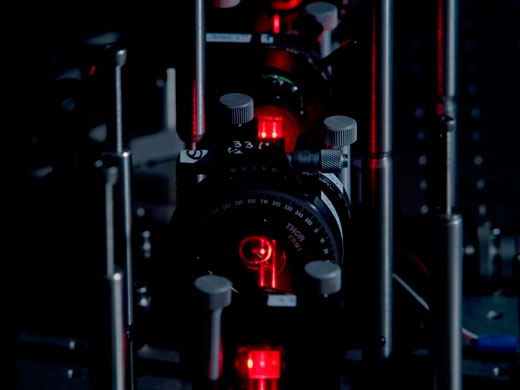Since that Golden Age of theoretical physics thought experiments, much has changed. In 1964, John Stewart Bell showed how the principle of locality, one of the key assumptions in the EPR paradox, conflicted with quantum theory and the upper limit on the strength of correlations that can be produced in any theory obeying local realism became Bell's inequality (we have too many articles on quantum mechanics for a narrow-enough search that will provide quality results detailing QM and EPR and Bell more thoroughly so results for Alice and Bob make more sense, as you will see if you read them).
Asher Peres, a quantum information theorist, once remarked jokingly in a letter to a colleague, Dagmar Bruß, that "Entanglement is a trick 'quantum magicians' use to produce phenomena that cannot be imitated by 'classical magicians'. When two particles are entangled, measurements performed on one of them immediately affect the other, no matter how far apart the particles are. What if, in an experiment, one considers a system that does not allow for entanglement? Will the quantum magicians still have an advantage over the classical magicians?"
A team of physicists recently sought to tackle this 'magic' question. They used a qutrit – a classical trit (a base-3 digit) that can exist in three possible states, basically a 3-D version of the better known qubit - consisting of a single photon that can assume three distinguishable states - and, they write in Nature of their experiment showing a system which does not allow for entanglement and still found results which cannot be interpreted classically.
"We were able to demonstrate experimentally that quantum mechanical measurements cannot be interpreted in a classical way even when no entanglement is involved," said Radek Lapkiewicz from the Vienna Center for Quantum Science and Technology at the University of Vienna.

The central part of the optical setup used to demonstrate that even a system which does not allow entanglement exhibits features commonly attributed to this phenomenon. (Credit: IQOQI; Jacqueline Godany 2011)
Quantum physics is not magic - but like that owl in the Tootsie Pop commercial, the magic number may be three
Quantum physics, to laypeople, makes little sense because it often contradicts what we perceive and experience and understand as classical physics. If we go into outer space and look at Earth, from our point of view we see only one hemisphere but as the Earth spins around its axis we can 'construct' an accurate picture of the total planet. We assume the shape of the continents stays the same, even while we cannot see them.
That's classical physics - experience and assumptions allow us to assign properties to a system without actually observing it.
That's not the case in a "quantum Earth". Unlike the planet we would see from space, where the various pieces fit together as they do in a puzzle, the pieces of the quantum Earth do not appear to fit together. Not all all its properties can be simultaneously well-defined.
Yet the pattern is not random: it is possible to predict by how much the individual parts will differ from each other after an observation. Confusing? Well, yeah, but that's why it seems like magic.
The 'magic number' may be three, the researchers say - a single three-state system (that qutrit again) is the simplest system in which the contradiction is possible, because a three-state system is indivisible.
Our experimental results are in conflict with any description of Nature that relies on a joint probability distribution of outcomes of simple set of measurements. This also precludes any description in terms of non-contextual hidden-variable models.
...
Our result sheds new light on the conflict between quantum and classical physics. To finish, we want to point out that any model-based on a joint probability distribution can in principle be non-deterministic. The experimental preclusion of such models highlights the fact that even for a single, indivisible quantum system, allowing randomness is not sufficient to allow its description with a conceptually classical model.
Or, if the owl makes more sense to you:
Read more about their photonic qutrit experiment, though it will cost you $32:
Citation: Radek Lapkiewicz, Peizhe Li, Christoph Schaeff, Nathan K. Langford, Sven Ramelow, Marcin Wieśniak&Anton Zeilinger, 'Experimental non-classicality of an indivisible quantum system', Nature 474, 490–493 (23 June 2011) doi:10.1038/nature10119




Comments